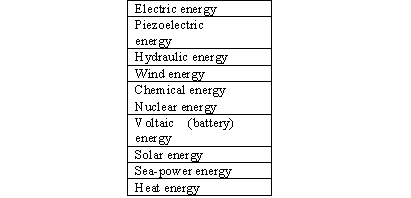CLASS
B
PHASE
DESCRIPTION
According to Michel Joly (1993), these lists represent “normative” methods. They help to solve problems, such as to satisfy a given need in a new or different way.
“[…] So to try and satisfy a need, I will try to make a means evocation list for my needs. The first normative method is therefore about making a means evocation list. But which means?
There is a wide range of possibilities:
- lists that are easy to make and recall a lot of means; energies, phenomena, irregular verbs of motion, customs tariffs (lists of cars), etc.;
- lists made by means of techniques like the “invention tree”;
- lists developed by experts, which are universal and idea generating.
Hereunder follow some examples:
The list of energies
The following energy list is very much used in technical normative researches:

The lighter tale story
Once upon a time there was a gas lighter manufacturer who was known worldwide. A day the competition put on the market a lighter whose lighting system was so competitive that it threatened the manufacturer’s sales. He needed to react promptly and launch a new product on the market. What was the matter, indeed? Why was that item so innovative? It was a common butane gas lighter. However, its flame was different, and so the way gas was set on fire. How to set butane on fire? This was the real problem.
Suddenly, a small creativity group started to work on that problem and made a list of energies.
Then the group began to think about the different lighting systems for each type of means evocation energy. They generated the following ideas: ? (electric): like the “Delco” system;
- (chemical): a highly exothermic fluid that is immediately set on fire, thus setting gas (hypergolic fuel) on fire;
- (nuclear): it follows the atomic battery principle, with a tritium condenser;
- (pneumatic): the Diesel engine principle: high temperature through isotermic pressure;
- (mechanical):a gyroscopic movement helps to rub on a given point...
Example 1: Arrange a list: the invention tre
It is used to examine a new type of remote-control switch , to switch on and off the current alternatively...
Evocation words
“Kent-Rosanov” is the most popular list. It includes some common names or descriptive adjectives carefully selected for their evocation quality. They are common words, rich in symbols and very useful when a group does not want to look for a particular list.
You take the first word from the list and you wonder how this concept can be associated to a problem to generate an idea. For example, the first word from the “Kent-Rosanov” list is “table”. You can either use this word straight away or list all thoughts that come to your mind, such as leg, drawer, mortise, button, ironware, marble, leaf, socket, varnish, paint, termite, operation, billiard, etc.
The “Kent-Rosanov” list can be customized: instead of starting straight away from the word “table”, you can make a list of ideas or words that come to your mind starting from that word and thinking about any possible analogies that it suggests, word by word.” (Joly, 1993)
CORRELATE
TECHNIQUES
REFERENCES
- Joly M., Des idées qui repportent... ca se trouve! Démystifier la créativité industrielle, Paris, Les Éditiond d'Organisation, 1992.